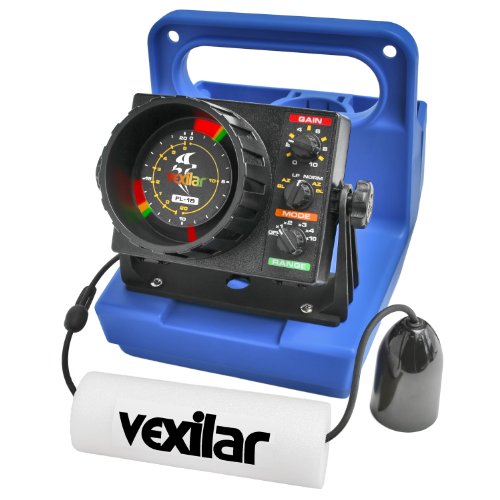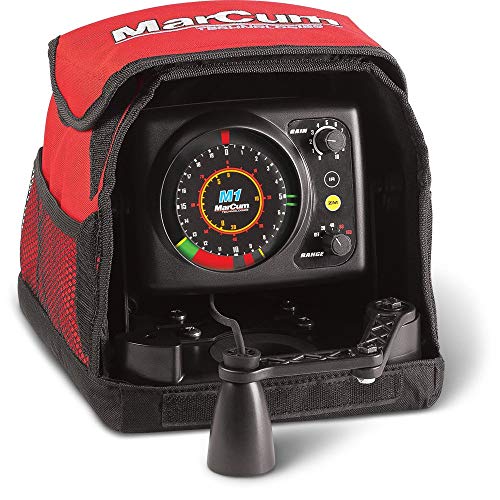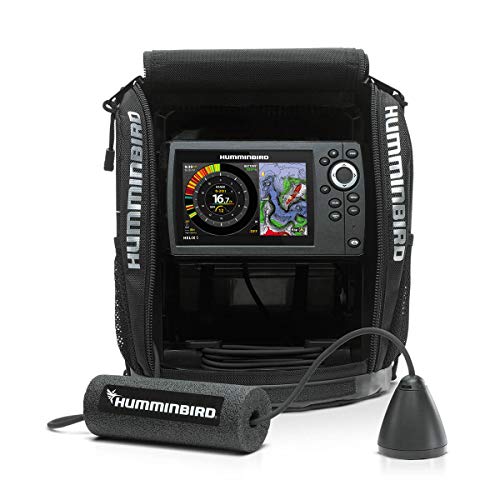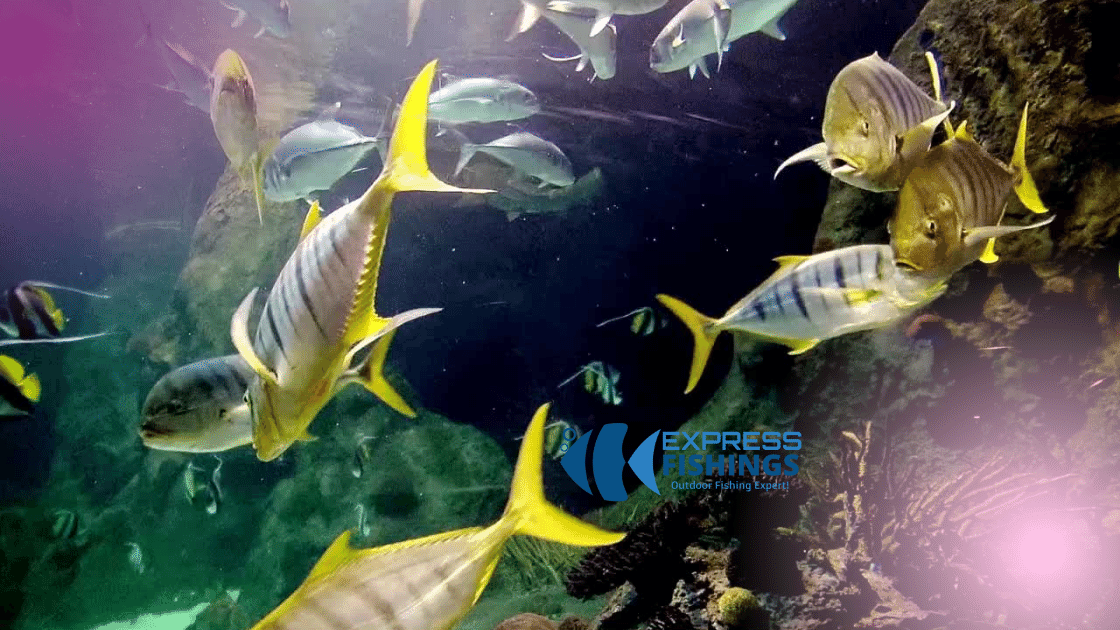Three companies dominate the ice fishing fish finder market: Vexilar, MarCum, and Humminbird. These names are well-known to anyone who has spent a lot of time on the ice. There are many new ways to watch fish approach your jig and you need to be aware of how they compare to the tried-and-true.
We’ve compiled an unparalleled resource that will help you to find the best ice fishing equipment after extensive research, field testing,g, and detailed comparison.
The best ice fishing flashers available today:
- Humminbird ICE 45 –Our Choice!
- Vexilar FL-18 –Our Choice!
- MarCum M3 –Our Pick FishUSA: Get $50 off
- Deeper Smart Sonar PRO+
- Humminbird ICE Helix 5
- MarCum LX-7 Ice Fishing Sonar System
Review of the Best Ice Fishing Finder Flasher
Humminbird ICE 45 –Our Choice!
Target Specification 2 1/2
Transducer angle:9 to 19 degrees
Battery life Multi-day
Weight: 10.9 pounds
The ICE-45 flasher from Humminbird is a great one, and it is easy to see why this brand is a favorite winter fisherman. This model was chosen over its siblings, ICE-35, and ICE-55 because for most people, the extras of the 55 won’t make a big difference. However, if you fish deeper, the 45 might be more powerful than the 35.
You can choose between a 19-degree cone angle orana a9-degree one. This gives you the ability to see fish in close up and with the same narrow cone that you use to fish with your friends. The only problem with the ICE-45 is its target separation of 2 1/2 inches. This makes it one of the less discerning. It might not matter to you but the ICE-45’s target separation is still better than its competitors.
The easy-to-read display with three colors is a favorite. It’s easy to see what’s under the ice with the many noise-reduction or gain steps. The digital depth meter at the center of the dial isa bonuss that we love about the 45. A wide-angle transducer is a great option if you have the space. It can be used in shallow water, where anglers often fish at 19 degrees. In 20 feet of wate,r you can see a cone measuring seven feet in diameter. A 9-degree cone is also available for those who jig deep. This can help to reduce interference if you have a friend in your shanty.
The transducer cable runs through a large foam floating, which allows you to adjust the depth of the hole. This is a great detail, but it can cause your line to tangle.
The battery life is amazing. You can expect to get 16 to 20 hours of juice under real-world conditions.
Pros
- Battery life is excellent
- Excellent dual cone angles
- Easy-to-read display
- Digital depth meter at the middle of the dial
- Bright display
- Amazing battery life
Cons
- We review the largest target separation among all models.
Vexilar FL-18 –Our Choice!
Target Specification 1/2
Transducer angle: 12 degrees
Battery life Multi-day
Weight:10.2 lbs.
Vexilar’s FL-18 flasher, like the ICE-45 of Humminbird and MarCum M3, has a large following. The FL-18 is simple to use, reliable, and cost-effective, even though there are other flashers.
It has a three-color, very legible display and the usual knobs for power and gain. There is no fancy digital depth meter. Instead, the bottom is judged by looking at the dial like you would with an M3. This simplicity is up to you, but it is worth noting that ice anglers often choose this model (2001) over more advanced, high-tech options. It works every season and produces fish after fish.
The Fl-18 has a low power mode which reduces battery consumption, but most importantly, it can see through weeds. The mode ignores vegetation when active. This allows you to see your jig in thicker material, where fish live, even though it isn’t.
You won’t miss any fish with the FL-18’s impressive target specification and 12-degree cone angle. The FL-18 is described as “barebones” but you can also call it “bombproof.” We are confident that this tried-and-true model will not let you down. It will also save you the frustration of having to deal with controls and features that you don’t understand.
The FL-18’s transducer cables are run through a foam flotation, similar to the Humminbird. Overall, we prefer MarCum’s cable arms.
As you would expect, battery life is great.
Pros
- Amazing target specification
- Very low power modeThe diall is easy to read and extremely bright
- Simple controls
- Amazing battery life
Cons
- Single cone angle
MarCum M3 –Our Choice!
Target Specification1
Transducer angle: 20 degrees
Battery life Multi-day
Weight:11 lb
MarCum flashers are legendary on hard water and people will not use any other brand. We chose the MarCum M3 flasher from their M series. It’s a great performer, with a great reputation, and is probably the most affordable MarCum flasher in terms of price and balancing features.
The three-color M3 dial is bright and easyto read. However, unlike the Humminbird, the depth below the transducer can be determined by looking at the bottom of the dial. It hangs its transducer froman arms, rather than using a floating float like allMarcuss. This helps reduce tangle and makes it easier to set up.
The M3 has a good target specification and a single 20-degree cone angle. This simple solution provides a large footprint with minimal interference. It all depends on your needs. Although we would give the advantage to the Humminbird, it is clear that the MarCum with its one-inch target specification is more discriminating.
The dial adjusts the power for depths of 20, 4,0, and 80 feet. Few anglers will ever require more power than the M3. The M3 is a popular choice because of its many gain options, excellent interference mitigation, and easy-to-use interface. Marcum’ss zoom can be adjusted infinitely, which is something no competitor offers. This makes it easy to see why so many anglers chooseMarcumm.
The battery life is amazing, so you can go on weekend trips without worrying.
Pros
- Excellent target specification
- Transducer cable system with great results
- Bright dial, easy to read
- Simple controls
- Infinitely adjustable zoom
- Amazing battery life
Cons
- Single cone angle
Deeper Smart Sonar PRO+
Target Specification 1/2
Transducer angle :Between 15 and 55 Degrees
Battery lifeNominally, 5.5 hours
Weight:3.5 ounces
The Pro+ by Deeper is an excellent idea. If you are looking for an ultra-lightweight system to use with your fish finder, this might be the right place. The Pro+ combines a sonar unit with a battery and small sphere to provide a fishfinder/flasher combination with many features and lots of benefits. It is small, about the same size as a baseball,l, and weighs only 3.5 ounces.
Take a look at our Deeper Sonar Review.
We love the dual transducer angles. They give us two options depending upon what we need, how deep we are fishin,g and how close we are to other anglers. This is a great feature. A 55-degree cone is a great feature for shallow water anglers who prefer to fish alone. These large angles can prove problematic if there’s more than one transducer in the water. It may not be the best choice if you fish regularly with friends.
You won’t be surprised at how many fish are coming towards your jig with a target size of only a half-inch.
The cordless design is also a big plus. Simply drop the Deeper sphere in the hole and get fishing. It’s easy to fish without getting in the way.
The display will appear clear when it is connected to your device. However, how easy it is to read will depend on the software you use to control the Pro+. It’s great that you can switch between a traditional flasher or standardfishfinderr mode. Both work well.
GPS is standard on Pro+. This can be useful if there are a lot of holes made in the ice. It can also help you keep track of the holes and mark those that produce.
The battery life is good and the unit will last about five hours on ice. The phone will quickly drain its batteries so be aware. This is perhaps the weakest link in an otherwise great design.
Pros
- Amazing target specification
- Two transducer angles, with a wide range of options
- Displays of the fish finder and flasher lights
- Cordless
Cons
- Fishing with friends is possible from anarrow-anglee cone angle
- The battery life is shorter than a flasher.
- Battery life is dependent on how the device is synchronized.
- The paired device is the best indicator of display quality
Humminbird ICE Helix 5
There are no products.
Target Specification2 1/2
Transducer angle:20 to 60 degrees
Battery life8-12 hours using a standard 7Ah battery
Weight: About 11 lbs.
Humminbird fish finders are the best in open water. We were eager to see how the Helix ICE would perform through a hole. These results were not disappointing. This is a good option for anglers who want to use the same gear all year.
The ICE has a hard-water-specific transducer. However, an optional open water model allows the Helix 5 to move quickly from one season to another. You can do it with a flasher!
The Helix 5 fish finder is a great choice for open-water pros. The Helix 5 is a great summer competitor, with its crisp resolution, GPS, maps, and large five-inch screen. This might be the best option if you love having these tools on your boat and would like to take them to the ice.
These cool add-ons might be argued by die-hard flasher enthusiasts. It’s great to have an integrated GPS that shows you where your holes are. This means you don’t have to guess what snow might do to the lake. This also means you don’t have to worry about finding the same amount of snow or depression each year and that you will always be able to fish in the exact spot you want. However, this extra can be a significant drain on your battery life and cannot be disabled.
You won’t see a lot of target separation with the Humminbird Ice45 flasher. However, the cone angle of 60 degrees will allow you to see 35 feet off bottoms in just 20 feet. This is something to be aware of, and it’s also something that will impress those who fish in shallow water.
However, if you fish with your friends, a cone angle of 20 degrees is not enough to prevent interference. Many users have problems with interference from flashers of similar frequency ranges. This can lead to serious problems.
In real-world conditions, battery life is acceptable. However, the brighter the LCD screen, however, the less juice that will last.
Pros
- Super-wide cone angle optionThe displayy is easy to read
- A great addition to GPS and maps is GPS and Maps
Cons
- We review the largest target separation among all models.
- Interference can be a problem and is made more difficult by a narrow cone angle.
- Flashers are more efficient than battery life
MarCum LX-7 Ice Fishing Sonar System
Specification of the Target:1/2
Transducer angle:8-20 degrees
Batterylife depending on the backlighting, it could take between 10-14 hours
Weight:12.3 lbMarcumm is at forefront of high-tech innovation and today they offer a glimpse at the future flashers with their LX-7. This sonar system offers a variety of display options and styles and can be described as an ice-specific combination of a flasher and fish finder. It also has the best of both. It boasts many powerful features that flashers lack.
The LX-7 is a flat LCDLCDy that measures 7 inches and offers a wide range of color options. It’s similar to a fish finder. The screen displays information at a glance about everything, from gain adjustment to battery life, and you can choose to display a traditional dial or vertical graphs. This gives anglers a level of personalization that is unmatched on the ice. This is something we really love, and we’re sure many anglers will also appreciate it.
You can also use the LX-7 to catch fish with very precise and powerful tools. The graphmodele allows you to view how fish behave over time and how fast they approach your jig. This flasher is a powerful tool, and pros swear by it. This unit is not cheap.
The LX-7s display has backlit and, if there is a weak link in the system, it will be here. Backlighting consumes power, just like a traditional fishfinder. To make it fully visible outside, keep the display light on high. This will make it less efficient in terms of battery life than other flashers.
The target specification is excellent and you have two options of cone angle. This means that you can be well served in shallow or deep waters, alone or with your friends. The MarCum transducer cable is suspended from a foamfloatt rather than being held by an arm, which we believe is better than an attached float.
Pros
- Unrivaled personalization and display options
- Dual cone angles
- Amazing target separation
- Amazing fishing tools
- Transducer cable system with great results
Cons
- If you use high levels of backlighting, battery life can be a problem.
- Expensive
Our Picks: The Humminbird Ice-45, MarCum M3, Vexilar FL-18
The technology for ice fishing is rapidly evolving. Systems like the Deeper Pro+ and the Humminbird Ice Helix 5 and the amazing MarCum LX-7 offer a glimpse into the future. We aren’t convinced, however, that these new devices will replace the tried-and-true.
Popular models include the ICE-45 and M3 as well as the FL-18. Some higher-end models costt more, and systems with more bells-and-whistles, but we believe there is a decreasing tech return on the higher-end models, at least for now.
We find that the target specification and battery life, transducer cone angle,s and ease-of-use are all roughly equal across the three models. It is up to you which option you choose, but you will be able to catch fish no matter what.
What is important in a Flasher?
Fishfinder vs Flasher
Let’s start with the important question.
Flashers
Flashers are named so because they have a rotating, multi-colored display and moving lights. These lights show the location of your Jig, the depth of the water below the transduce,r and whether there are fish.
This is done by emitting sonar pulses, which are reflected off the bottom and other objects. These signals are then converted into visual cues. Although the exact details of control interfaces can vary from model to model, they usually include a zoom, a power/depth select,r, and someone-interference options.
It can be difficult to get used to flashers if you aren’t familiar with the display on yourfishfinderr. But once you become comfortable reading them, you will be amazed at how effective they are in telling you when fish have been caught.
They can be tucked into a 5-gallon bucket like many other ice fishing accessories. This allows you to easily organize your gear and get it onto the ice. These models also have powerful batteries that can withstand the cold and can last at least a few monthsDaysonn the ice!
They are purpose-built for winter and can withstand extreme cold. This is a big plus as freezing temperatures can kill batteries. Flashers are not affected by this.
These are all great points, but it is important to be aware of the limitations flashers have. They are a one-season piece, and they can be expensive. You’ll be able to handle sticker shock better if you know this before you go.
Fishfinders
Open water fish finders are a staple. They use sonar to locate fish. However, unlike flashers, they offer more information and visual cues via theirLCDss. They are generally more advanced and complex than the average flasher. The most advanced models employ CHIRP (CompressedHigh-Intensityy Radiated Pulse), which is an advanced sonar system that emits short ‘pings’ at gradually rising frequencies to pinpoint fish in the water column. Fishfinder is a must-have tool for anyone who wants to quickly locate fish in deep waters. They’re a great tool for ice fishing but they can be a little too much.
They often have extras that can be useful in open water but don’t do much for ice fishing. For example, CHIRP sonar can be used in 800 feet of water to fish onshore, but not over an augered hole. GPS, which can be used to locate and mark structures or snow-covered holes, is an exception.
Humminbird is a company that has built its reputation on fish finders. Instead of creating a new digital fish finder, they just add an ice-capable transducer, altering the software to allow dual-modes, which allows you to switch between flasher orfishfinderr displays.
These are great for new hard water anglers, who are comfortable with fish finders. However, we don’t think they are as competitive as popular flashers.
Because battery life is often an issue. While some may argue that this is unfair, here are the facts. Fishing in open water requires that your screen be bright enough for you to read. This usually means you need to set the brightness to at least eight or even ten. You’ll use up your battery faster than a friend using a flasher.
These units offer all-season operation as their main advantage. You can also run your fish finder in open water if you switch transducers. However, flashers are often better than fish finders for ice fishing. This is especially true when it comes to lag.
We mean the time it takes the unit to detect movement and see a fish racing towards your jig. Flashers are real-timee”; fish finders, on the other hand, have a slight delay due to their design.
Battery life
We want more, so we are happy to have as many as possible. Fishfinderss are at a disadvantage because a battery can last as long as the fish you plan to catch.
You won’t be disappointed if you keep this in mind when selecting your gear.
Screen brightness
This is crucial when fishing outdoors. This won’t be as important if you live in a shanty. This may sound like a fight, but we have found that Vexilar has the brightest screens. Even the most expensive fish finders can’t compete with Vexilar in bright sunlight.
Separation with a specific goal
Target separation refers to a sonar system’s ability to distinguish between two or more targets close together. Asolarr system’s ability to detect individual objects, such as your jig or approaching fish, is better if it has a shorter ping.
The target separation is often defined in inches. You want to find the smallest number possible.
Transducer Cone Angle
The transducer cone angle is more important in ice than in open water. It determines how large the area that sonar searches. To tell you what fish are near your jig, the cone must be wider than the water in which you fish. A cone that is too narrow can cause your jig to leave the sonar’s active zone.
You may believe that bigger is better, but it’s not true. A wide beam can cause interference and overlap if you are fishing in a shanty with your friends. Many flashers have two cone angles, wide and narrow. Or you can choose to just use one split-the-difference number.
Calculating the Cone Footprint
It is simple to calculate the area that yourfishfinderr or flasher will cover using a little trigonometry. The following formula can be used to calculate the area your flasher or fish finder will cover using Windows”scientific function’ calculator:
TAN = Cone Angle x Water Depth.
The following calculation is applicable if your transducer has an angle of 15 degrees and your fish in 20 feet of water:
TAN (15)x20 = diameter
.2679 x 20, = 5.36 feet
This means that your flasher would create an oval with a diameter of 5.36 feet at its bottom. A 10 foot-long transducer would produce a cone of only 2.68 feet in depth. This is why the angle is important in the shallows.
It is important to remember that not all transducers are equal. Interference can be caused by multiple transducers being near each other. A happy medium is ideal, as you may spend a lot of time on the ice with friends.












